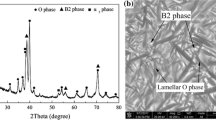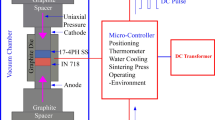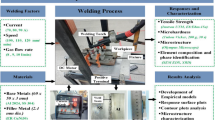Abstract
Spark plasma diffusion welding (SPDW) is a powerful technique for joining materials at a remarkably short time with excellent quality. In this paper, SPDW of 5A06Al alloy to itself was conducted with Al–20Cu–5Si–2Ni brazing filler alloy added as the interlayer. In the bonding temperature ranging from 520 to 550°C, pressure from 0.3 to 6 MPa, and holding time from 10 to 20 min, the optimal joint was obtained at bonding temperature of 540°C and pressure of 6 MPa for 10 min. Results showed that the void-free 5A06Al/5A06Al-bonded joint was obtained at the optimized parameters with the aiding of electric current and Al–20Cu–5Si–2Ni interlayer. Increasing the bonding pressure produced more refined grains in the bonding joint and was therefore beneficial to the bonding quality. The formation of refined eutectic phases, the accelerated atomic diffusion, the sufficiently removal of oxide film, and the evidently more narrowed bonding interface areas were helpful to strengthen the SPDW joint. The most efficient bonding joint had a tensile strength of as high as 220 MPa and exhibited typical fine ductile dimple fractography. Comparatively, the poorest joint quality was obtained at lower bonding temperature and pressure, i.e., bonding temperature of 530°C, pressure of 0.3 MPa, and holding time of 10 min.















Similar content being viewed by others
Data availability
The data sets supporting the results of this article are included within the article.
References
Chen JC, Wei YH, Zhan XH, Pan P (2017) Weld profile, microstructure, and mechanical property of laser–welded butt joints of 5A06 Al alloy with static magnetic field support. Int J Adv Manuf Technol 92:1677–1686
Tsao LC, Weng WP, Cheng MD, Tsao CW, Chuang TH (2002) Brazeability of a 3003 Aluminum alloy with Al–Si–Cu–based filler metals. J Mater Eng Perform 11:360–364
Chang SY, Tsao LC, Li TY, Chuang TH (2009) Joining 6061 aluminum alloy with Al–Si–Cu filler metals. J Alloys Compd 488:174–180
Luo W, Wang LT, Wang QM, Gong HL, Yan M (2014) A new filler metal with low contents of Cu for high strength aluminum alloy brazed joints. Mater Des 63:263–269
Jacobson DM, Humpston G, Sangha SPS (1996) A new low–melting–point aluminum braze. Weld J Res Suppl 75:243–250s
Pei C, Wu X, Zhang GQ, Cheng YY, Ren XY, Wang W, Xiong HP (2020) Microstructures and mechanical properties of brazed 6063 aluminum alloy joint with Al–Cu–Si–Ni filler metal. Weld World 64:1933–1938
Zhang GW, Bao YF, Jiang YF, Zhu H (2010) Microstructure and mechanical properties of 6063 aluminum alloy brazed joints with Al–Si–Cu–Ni–RE filler metal. J Mater Eng Perform 20:1451–1456
Chang SY, Tsao LC, Lei YH, Mao SM, Huang CH (2012) Brazing of 6061 aluminum alloy/Ti–6Al–4V using Al–Si–Cu–Ge filler metals. J Mater Process Technol 212:8–14
Matsui M, Kondou K, WadaK OO (2011) Effects of post heat treatment on 5052Al and 6063 aluminum joints during pulsed electric current bonding. Weld J 25(03):159–165
Wang CY, Li XF, Zhong ZH, Song KJ, Wang GP, Zhou W, Wu YC (2020) Microstructure and mechanical properties of W/steel joints diffusion bonded with Nb and Nb/Ni interlayers by spark plasma sintering. J Adhes Sci Technol 34(24):2638–2651
Wang B, Jiang SS, Zhang KF (2019) Pulse current auxiliary TLP diffusion bonding of SiCp/2024Al composite sheet using mixed Al–Cu–Ti powder interlayer. Int J Adv Manuf Technol 65:1779–1784
Naveen Kumar N, Janaki Ram GD, Bhattacharya SS, Dey HC, Albert SK (2015) Spark plasma welding of austenitic stainless steel AISI 304L to commercially pure titanium. Trans Indian Inst Metals 68(Suppl 2):S289–S297
Yang Z, Hu K, Hu DW, Han CL, Tong YG, Yang XY, Wei FZ, Zhang JX, Shen Y, Chen J, Wu XG (2018) Diffusion bonding between TZM alloy and WRe alloy by spark plasma sintering. J Alloys Compd 764:582–590
Chen C, Qian SF, Liu R, Wang S, Liao B, Zhong ZH, Cao LF, Coenene J, Wu YC (2019) The microstructure and tensile properties of W/Ti multilayer composites prepared by spark plasma sintering. J Alloys Compd 780:116–130
Li HX, Wang ZQ, Zhong ZH, Wen Q, Song KJ, Zhang HB, Wu YC (2018) Micro–alloying effects of yttrium on the microstructure and strength of silicon carbide joint brazed with chromium–silicon eutectic alloy. J Alloys Compd 738:354–362
Kondou K, Matsumoto N, Wada K, Ohashi O (2009) Effect of bonding conditions on joints of 5052Al and 6063Al in pulsed electric current bonding. Weld J 23(11):810–816
Xie GQ, Ohashi O, Wada K, Ogawa T, Song MH, Furuya K (2006) Interface microstructure of aluminum die–casting alloy joints bonded by pulse electric–current bonding process. Mater Sci Eng A 428:12–17
Munir ZA, Anselmi-Tamburini U, Ohyanagi M (2006) The effect of electric field and pressure on the synthesis and consolidation of materials: a review of the spark plasma sintering method. J Mater Sci 41:763–777
Chikui N, Furuhata H, Ymaguchi N, Ohashi O (2004) Comparison of joints by pulse electric current bonding and diffusion bonding (in Japanese). J Jpn Inst Metals 68:515–518
Rezaei M, Jabbari AH, Sedighi M (2020) Investigation of surface roughness effects on microstructural and mechanical properties of diffusion bonding between dissimilar AZ91–D magnesium and AA6061 aluminum alloys. Weld World 64:949–962
Wachowski M, Kosturek R, Sniezek L, Mróz S, Stefanik A, Szota P (2020) The effect of post–weld hot-rolling on the properties of explosively welded Mg/Al/Ti multilayer composite. Materials 13(8):1930–1944
Wang X, Casolco SR, Xu G, Garay JE (2007) Finite element modeling of electric current–activated sintering: the effect of coupled electrical potential, temperature and stress. Acta Mater 55:3611–3622
Rathel J, Herrmann M, Beckert W (2009) Temperature distribution for electrically conductive and non–conductive materials during field assisted sintering (FAST). J Eur Ceram Soc 29:1419–1425
Wu F, Zhou WL, Han YJ, Fu XS, Xu YJ, Hou HL (2018) Effect of alloying elements gradient on solid–state diffusion bonding between aerospace aluminum alloys. Materials 11:1446
Ujah C, Popoola O, Aigbodion V (2019) Optimisation of spark plasma sintering parameters of Al–CNTs–Nb nano–composite using Taguchi design of experiment. Int J Adv Manuf Technol 100(5–8):1563–1573
Hasan M, Zhao JW, Huang ZY, Wei DB, Jiang ZY (2019) Analysis and characterisation of WC–10Co and AISI 4340 steel bimetal composite produced by powder–solid diffusion bonding. Int J Adv Manuf Technol 103(9):3247–3263
Hooshmand MS, Zhong W, Zhao JC, Windl W, Ghazisaeidi M (2020) Data on the comprehensive first–principles diffusion study of the aluminum–magnesium system. Data Brief 30:105381
Code availability
Not applicable.
Funding
The authors received financial support from the National Natural Science Foundation of China (No. 51905143 and 31971594), and China Postdoctoral Science Foundation (2017M612064).
Author information
Authors and Affiliations
Corresponding authors
Ethics declarations
Ethics approval
Not applicable.
Consent to participate
Not applicable.
Consent for publication
Written informed consent for publication of this paper was obtained from Hefei University and Technology and all authors.
Competing interests
The authors declare no competing interests.
Additional information
Publisher’s note
Springer Nature remains neutral with regard to jurisdictional claims in published maps and institutional affiliations.
Highlights
• Spark plasma diffusion bonding of 5A06Al with interlayer was demonstrated.
• The influence of bonding conditions on joint microstructure and mechanical performance was determined.
• The temperature-pressure-current auxiliary bonding mechanism was analytically presented.
• The joint strength reached 220 MPa, which is doubled compared with vacuum brazed joint.
• Bonding parameters optimization was performed to produce efficient joints.
Rights and permissions
About this article
Cite this article
Song, K., Lv, L., Zhu, S. et al. Microstructure and mechanical properties of spark plasma diffusion-bonded 5A06Al joints with Al–20Cu–5Si–2Ni interlayer. Int J Adv Manuf Technol 114, 3627–3643 (2021). https://doi.org/10.1007/s00170-021-07094-3
Received:
Accepted:
Published:
Issue Date:
DOI: https://doi.org/10.1007/s00170-021-07094-3




